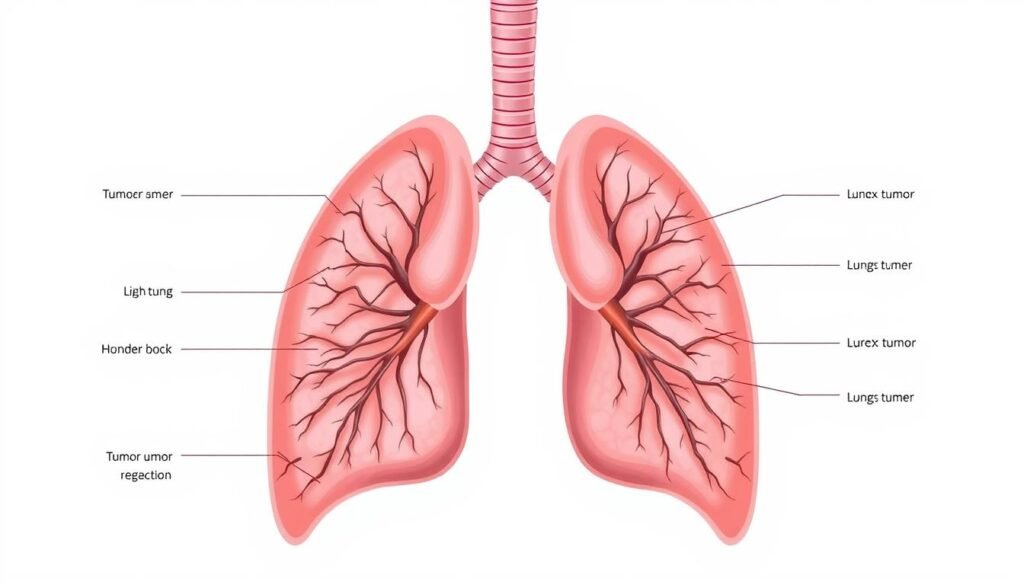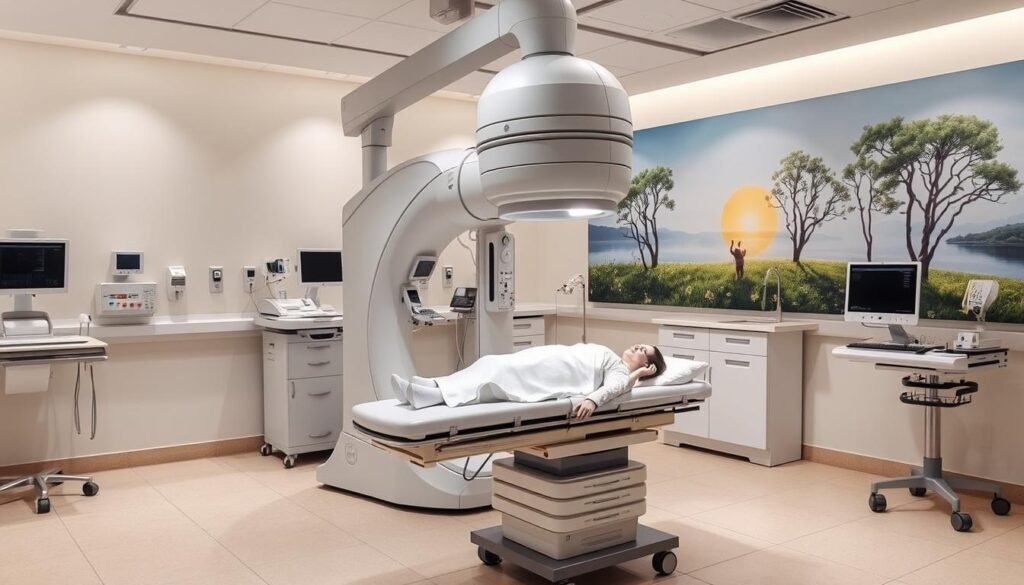Lung cancer leads in cancer deaths globally, with 18% of all cases. In the US, about 238,340 new cases and 127,070 deaths are expected in 2023. These numbers highlight the need for better cancer treatments.
Treatment for lung cancer has grown a lot, offering many safe and effective choices. Options include surgery, chemotherapy, radiation, targeted therapy, and new immunotherapies. These treatments get better and more personalized, improving survival and life quality. Learn about these advancements at this link.
Key Takeaways
- Lung cancer accounts for 18% of all cancer deaths globally.
- Current treatment options include surgery, chemotherapy, and targeted therapies tailored to individual needs.
- Personalized medicine enhances treatment efficacy and patient quality of life.
- Advancements in immunotherapy represent a new era in lung cancer treatment.
- Understanding lung cancer types is crucial for developing effective treatment strategies.
Understanding Lung Cancer Types
Lung cancer is mainly divided into two types: non-small cell lung cancer (NSCLC) and small cell lung cancer (SCLC). It’s important to know the differences. This helps doctors create the best treatment plans and can improve patient outcomes.
Non-Small Cell Lung Cancer (NSCLC)
Non-small cell lung cancer makes up about 85% of cases. It includes different subtypes like adenocarcinoma, squamous cell carcinoma, and large cell carcinoma. Each one has unique cancer cell features, affecting how doctors treat it. The most common subtypes are:
- Adenocarcinoma: About 40% of lung cancers.
- Squamous Cell Carcinoma: Makes up 25%-30% of cases.
- Large Cell Carcinoma: Less frequently seen.
Small Cell Lung Cancer (SCLC)
Small cell lung cancer accounts for 10%-15% of lung cancer cases. It grows quickly and spreads early, often needing chemotherapy and radiation. SCLC usually has a worse outlook than NSCLC because of how aggressive it is.
Different lung cancer types show why getting the right diagnosis is crucial. They also highlight the importance of tailored treatment plans for each type.
| Lung Cancer Type | Percentage of Cases | Main Treatment Approaches |
|---|---|---|
| Non-Small Cell Lung Cancer (NSCLC) | 85% | Surgery, Chemotherapy, Targeted Therapy |
| Small Cell Lung Cancer (SCLC) | 10%-15% | Chemotherapy, Radiation Therapy |
Importance of Staging in Lung Cancer Treatment
Staging lung cancer is key in planning patient care and choosing the best treatments. It helps doctors understand how far the cancer has spread. They use stages from 0 (least severe) to IV (most severe) to describe it. The stage of the cancer affects what treatments like surgery or chemotherapy may be used.
How Staging Affects Treatment Options
Knowing the stage of lung cancer is important for picking the right treatment. The TNM system shows the size of the tumor, if cancer has reached the lymph nodes, and if it has spread to other parts of the body. The latest update in 2017 used lots of data from patients. This helps doctors be more precise in staging and treatment.

Correctly figuring out the cancer stage lets doctors create personalized treatment plans. They use imaging, endoscopies, and inspect tissue samples. This helps tell the difference between cancerous and non-cancerous growths. Knowing the specifics of a patient’s cancer leads to better treatment choices and chances of success.
| Stage | Description | 5-Year Survival Rate |
|---|---|---|
| Stage 0 | Pre-invasive | Varies |
| Stage I | Localized with no nodal involvement | Approximately 70% |
| Stage II | Regional involvement | Approximately 50% |
| Stage III | Locally advanced disease | 13-36% depending on subclassification |
| Stage IV | Advanced or metastatic disease | 5-10% |
Effective staging of lung cancer not only helps in choosing treatments but also greatly impacts survival rates. For more on managing lung cancer, check out this detailed resource.
Current Treatment Options for Lung Cancer
The choices for treating lung cancer depend on its type, stage, and the patient’s health. Knowing these options helps in making the best plan for cancer care.
Surgery: A Primary Treatment Method
Surgery is key for early non-small cell lung cancer (NSCLC). It is used when the cancer is just in one spot. There are a few surgery types, like:
- Lobectomy: Taking out a lobe of the lung, often done for early cancer.
- Segmentectomy: Removing a smaller lung part, for tiny tumors.
- Pneumonectomy: Getting rid of one whole lung, needed for big tumors.
These surgeries increase the chance of beating cancer. For example, after surgery for Stage 1 cancer, most patients don’t see their cancer return for at least five years.
Chemotherapy: When and How It’s Used
Chemotherapy is crucial if surgery isn’t an option or after surgery. It uses strong drugs to attack fast-growing cancer cells. Cisplatin and carboplatin are common choices. For late-stage cancer, the average survival with chemo is 8–10 months. But, chemo also affects healthy cells, causing side effects.
Radiation Therapy: Targeting Cancer Cells

Radiation therapy uses powerful rays to fight cancer after surgery or if surgery isn’t possible. SBRT, a type of radiation, targets cancer cells accurately to protect healthy tissue. It helps NSCLC patients when cancer stays in the chest. When cancer is advanced, it eases symptoms like pain. Learn more about it in this guide on radiation therapy.
Choosing the best mix of treatments is crucial for the best lung cancer care.
Targeted Therapy for Lung Cancer
Targeted therapy is a rising star in lung cancer treatment, thanks to ongoing research. It uses drugs designed to directly attack cancer cells. These drugs target genetic changes unique to each patient. This way, doctors can create personalized treatment plans. It increases the likelihood of beating the cancer.
What is Targeted Therapy?
Targeted therapy zeroes in on genetic changes in lung cancer cells, such as those in the EGFR or ALK genes. These genes affect how cancer responds to treatments. This highlights the role of genetic profiling. For example, EGFR mutations are seen in 10% to 80% of NSCLC cases. Patients with these mutations usually respond well to treatment with EGFR tyrosine kinase inhibitors.
Benefits and Side Effects of Targeted Therapy
The benefits of targeted therapy for lung cancer include:
- Improved survival rates: Studies show that targeted therapies can boost survival in advanced NSCLC cases.
- Fewer severe side effects: These therapies tend to cause fewer serious side effects compared to traditional chemotherapy.
- Tailored treatment: Customized treatment plans are possible, thanks to personalized medicine.
Yet, patients might face side effects like rash, diarrhea, or fatigue. Continuous care from health professionals is critical. They help manage side effects and adjust treatments as needed. Sometimes, cancer develops resistance to the therapy. Techniques like CISH are used to keep track of these changes.

| Type of Mutation | Frequency in NSCLC | Treatment Response |
|---|---|---|
| EGFR | 10% – 80% | Positive response to EGFR inhibitors |
| KRAS | Up to 30% | Negative predictor |
| T790M (resistance mutation) | Common | Secondary resistance to treatment |
Immunotherapy: A New Era in Lung Cancer Treatment
Lung cancer treatments have greatly improved with immunotherapy. This approach targets non-small cell lung cancer (NSCLC). The body’s immune system is boosted to attack cancer cells. Immune checkpoint inhibitors are key, stopping proteins that shield cancer from immune cells.
How Immunotherapy Works
Immunotherapy boosts the body’s immune fight against lung cancer. It blocks proteins like PD-1 and PD-L1. This lets T cells destroy cancer cells that hide from the immune system. Studies show about 20% of advanced NSCLC patients respond to it. Some even see this response last 18 months. Researchers are testing new combinations to further cancer treatment.
Discover more about these cancer treatment advances.
Common Immunotherapy Drugs
Pembrolizumab and nivolumab are leading drugs in lung cancer care. Pembrolizumab is recognized by the FDA for NSCLC, showing a 21% response rate. Nivolumab, especially with chemo, shows a 33% to 47% response in NSCLC patients.
These drugs work well in certain lung cancer types. For instance, nivolumab helps those with squamous cell carcinoma live longer. This shows immunotherapy’s role in fighting lung cancer.
| Drug | Indication | Response Rate (%) | Survival Advantage |
|---|---|---|---|
| Pembrolizumab | NSCLC | 21 | FDA breakthrough designation |
| Nivolumab | NSCLC | 33-47 (with chemotherapy) | Enhanced survival in squamous cell cancer |
| Nivolumab + Ipilimumab | NSCLC | 44-65 (1-year survival) | Combination regimen effectiveness |
| Pembrolizumab | SCLC | 18 | Treatment response |
Lung Cancer Treatment with Demonstrated Safety Profile
It’s crucial to know how safe lung cancer treatments are for doctors and patients alike. There are many treatments backed by solid research. These studies show how well the treatments work and their side effects. This makes choosing a treatment easier and more personal.
Evidence Supporting Treatment Safety
Many patients move to second-line therapies if their first treatment doesn’t work. For example, 66.2% received alectinib, and 33.8% got ceritinib. Alectinib had a 61.0% 12-month progression-free survival (PFS) rate, better than ceritinib’s 54.5%. Alectinib also had lower risks of the cancer getting worse or death. This supports its safe use in treating lung cancer.
| Treatment | 12-Month PFS Rate | Hazard Ratio (HR) | Adverse Events |
|---|---|---|---|
| Alectinib | 61.0% | 0.61 | Elevated AST/ALT (23.3%) |
| Ceritinib | 54.5% | N/A | Diarrhea (36.4%) |
Alectinib has fewer cases of the cancer spreading to the brain. It works better, especially if the first treatment failed. These results pinpoint why it’s important to understand the safety of lung cancer treatments.
Patient Experiences with Safe Treatments
Patients’ stories highlight the benefits of reliable treatment options. Adverse events like diarrhea and fatigue are less common with the latest therapies than with old chemotherapy. Patients feel their life quality is better with treatments such as alectinib. This is due to the better handling of side effects.
There’s a clear shift towards treatments proven by research, which increases patients’ trust in their care. As treatments become more customized, patient happiness grows.
Minimally Invasive Surgery Techniques
Minimally invasive surgery has become very popular for lung cancer. It uses smaller cuts which helps patients heal faster. This method is better for both patients and doctors. Thanks to new tech, patients see better results and have a better life while recovering.
Benefits of Minimally Invasive Approaches
The chances of dying soon after surgery are lower with these methods. This is true for both early and late stages of lung cancer. Even older patients do well with minimally invasive surgery. People can leave the hospital sooner and get back to their lives quickly.
Common Procedures and Their Recovery
Two common minimally invasive surgeries are VATS and robotic-assisted surgery. They’re popular because they work well and rarely need to change to open surgery. Patients usually stay in the hospital for about 8.6 days. This is less than the 9.7 days for traditional surgery. With fewer problems and less blood loss, recovery is easier.
Participating in Clinical Trials
Joining lung cancer clinical trials is crucial for advancing medicine and accessing new treatments. Those who participate get thorough checks by medical experts. They look at your health history and current condition. The goal is to benefit the participants safely.
What to Expect from a Clinical Trial
Expect a detailed journey with consent forms, treatment plans, and possible outcomes. Studies like the one on pembrolizumab show safety is a priority. Some trials show that treatments can shrink tumors, raising hope for longer life and better health.
Eligibility and Safety Measures
Entering a trial depends on the cancer type, stage, and past treatments. Safety is key, with strict rules and monitoring for any bad effects. For example, new treatments are closely watched for side effects. This careful observation helps improve future therapies for more people.
| Parameter | Details |
|---|---|
| Objective Response Rate | 28% for Mobocertinib in mNSCLC |
| Median Duration of Response | 17.5 months |
| Median Progression-Free Survival | 7.3 months |
| Total Patients in Study | 170 patients |
| Adverse Events | Commonly diarrhea and rash |
| Participation Rate | Less than 5% of adults with cancer |
Conclusion
Lung cancer treatment has grown a lot, offering many safe options. Immunotherapy is a big step forward, especially for non-small cell lung cancer (NSCLC). This makes up about 85% of all lung cancer cases. The progress shows how the immune system can fight cancer cells, giving new hope.
Understanding these treatments is key as more people are diagnosed with advanced lung cancer. Immunotherapy is changing lung cancer care. It works better and is safer than old treatments like chemotherapy. Talking with doctors about these options helps patients make choices that fit their needs.
New studies and trials will keep improving lung cancer treatment. They aim for breakthroughs to make patients’ lives better and increase survival. A well-rounded treatment plan is important. It combines new methods and personalized care to give the best support. For more info on new treatments, check out this article on immune checkpoint inhibitors in lung cancer treatment.